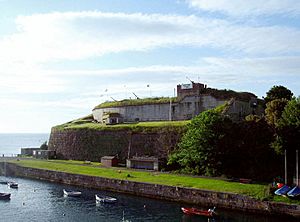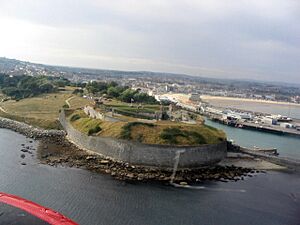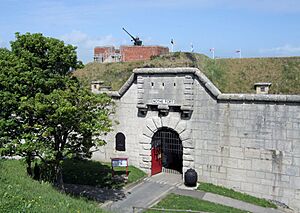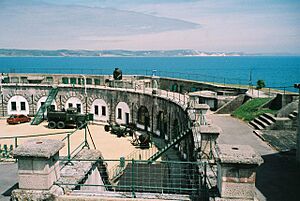Nothe Fort facts for kids
Nothe Fort is an amazing old fort in Weymouth, Dorset, England. It sits right at the end of the Nothe Peninsula, which sticks out into the sea. From here, it watches over Weymouth Harbour.
This strong coastal defence was built between 1860 and 1872. Its main job was to protect Portland and Weymouth Harbours. At that time, Portland was a very important base for the Royal Navy. The fort is shaped like the letter D. It was built with special bomb-proof rooms called casemates and deep storage areas for ammunition, known as magazines.
The fort was no longer needed by 1956. The local council bought it in 1961. Today, it is a popular museum. It is one of the best-preserved forts of its kind in the country. The fort and its main gate have been special listed buildings since 1974.
Contents
History of Nothe Fort
Building and Military Use
Work on Nothe Fort began in 1860. First, the site was made flat, and a sea wall was built. The 26 Company Royal Engineers took over the building work in 1862. The fort was fully ready by 1872. It cost a lot of money, about £117,049.
The fort had three main levels. The lowest level was the magazine, where ammunition was stored. The middle level had casemates. These were rooms designed to hold heavy cannons and provide living space for soldiers. The top level was the ramparts. This raised platform was used to fire smaller weapons like muskets during attacks.
The first soldiers to live at the fort were from No. 2 Battery Royal Artillery. They installed the first cannons. These included two 64-pounders, four 9-inch rifled muzzle loaders, and six 10-inch cannons. Later, in the 1890s, some of these were replaced with even bigger 12.5-inch guns.
In the early 1900s, newer cannons were invented. The old guns were removed and replaced with three 6-inch Mark VII breechloading naval guns. To move the heavy 100-pound shells, special hoists were put in place.
Nothe Fort in World War II
In 1938, the fort was changed to store anti-aircraft ammunition for the south west of England. An electric hoist and a loading platform were added. Nothe Fort saw action during World War II. In July 1940, two ships came into the area without identifying themselves. The fort fired its guns as a warning. The ships quickly turned on their lights. They were refugees from the Channel Islands.
During the war, the fort had four Vickers 3.7-inch anti-aircraft guns. These were placed on a special platform. Later, a Bofors 40 mm gun replaced them. The fort was no longer needed for defence by 1956. After that, the Royal Navy used it to store equipment.
Nothe Fort as a Museum
By 1961, the Navy didn't need the fort anymore. It was sold to the local council. The fort was empty for a while and sadly became damaged by vandals. Many ideas were suggested, even turning it into a fancy hotel. Work to make it a hotel started in 1971 but stopped soon after.
In 1980, the Weymouth Civic Society took over the fort. They started working to restore it. This was a big job, and many people helped. During the Cold War, part of the fort's magazine level was used as a nuclear shelter. It had command rooms, living areas, and strong blast doors.
Nothe Fort has slowly become a wonderful museum and tourist attraction. It is still open to the public today. After the first restoration, the fort received a large grant of £1.8 million. Local groups and English Heritage also invested more money. The fort is run by a small team of staff and many dedicated volunteers.
The museum has lots to see. You can find models, items from World War II, and original cannons and guns. There are also British and American WWII vehicles. The fort has many displays and audio-visual shows. The courtyard often hosts fun community events like festivals and concerts.
In 2007, a survey found that Nothe Fort was voted one of the spookiest places in the UK! In 2012, during the Summer Olympics, many people volunteered at the fort. 150 people helped as marshals. About 4,600 spectators came each day to watch the games from the fort.
See also
 In Spanish: Fuerte Nothe para niños
In Spanish: Fuerte Nothe para niños
- Brewers Quay, a local shopping and heritage centre






